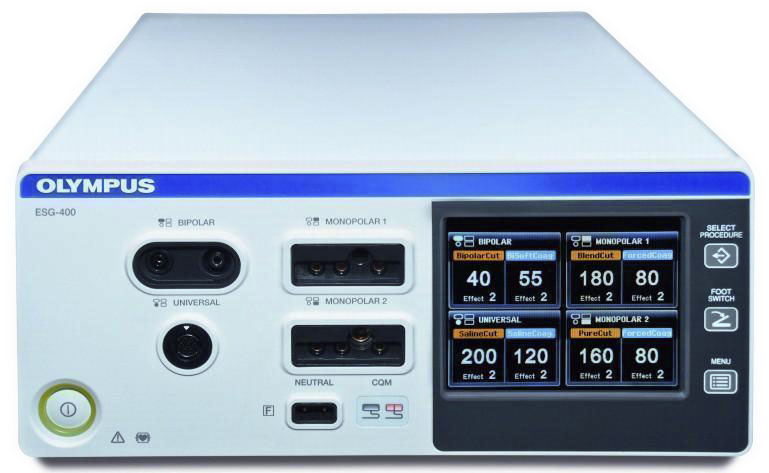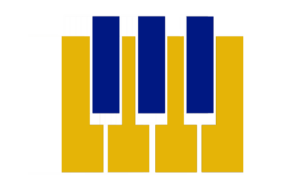
Olympus is a manufacturer of optical and digital devices that was founded in Japan in 1919. In addition to cameras and dictation machines, its products also include endoscopes, microscopes, as well as other medical and industrial devices. Olympus’ global market share in the field of gastrointestinal endoscopy, for example, is around 70 %. Olympus therefore attaches great importance not only to compliant use, but also to high quality – as is the case with the ESG-300 electrosurgical generator with the innovative Thunderbeat cutting head.
The navigation sounds in Olympus medical devices were previously provided by standard beep tones from a common tone generator. The sound output was tuned mathematically instead of musically, which gave it an unpleasant “out of tune” feel. In addition, some of the information was difficult to understand, which led to a complete redesign. The challenge was not only to improve navigation, but also to create recognizability. The task was to solve the problems and increase the intuitive qualities of the navigation sounds while tying it into the Olympus corporate sound design.
In addition to providing an intuitive and aesthetic system to deliver auditory status information to the user, it was possible to provide a measurable increase in quality perception. This was achieved by creating a new category of information to reduce warning signals. In addition to harmonization with other Olympus sound communications, the entire medical product range is updated to be recognized and understood by operators of other Olympus medical devices.
OLYMPUS offers a wide range of medical devices. However, some products were not developed directly by Olympus, which meant that the navigation sounds in some models were different. This showed an obvious need for uniformity.

The sound navigation systems have been updated and it was stipulated that they be identical across all models. To ensure that the sound signals were reduced to an absolute minimum, the operations were divided into sound categories. Clear and understandable sounds were assigned to each operating mode (e.g. cutting or coagulating), making it much more intuitive to use.
It was brought to our attention that OLYMPUS medical devices were generating an unusually large number of warning signals. Even in situations where there was no need for an alarm, the device would emit high volume alerts. This gave the impression that the equipment was either difficult to use or constantly failing, leading to a negative perception of the quality of the equipment.
DIN EN 60601-1-8 / IEC 60601-1-8: 2006 provides clear specifications for alarm / error sounds. They are required by law to have certain warning features and they cannot be switched off.

Our investigations have shown that in many situations in which these alarms sound, there were no faults or malfunctions as defined by the DIN standards. In fact, the device only provided information – important information, but no reason for an alarm. The solution was to create a new information set of tones using the more user-friendly product navigation tone palette and not having to use high volume warning signals. This immediately reduced the number of alerts and significantly increased the perception of reliability and quality.
The current generator models use sine waves as signals.
One or more numerical Hertz values are defined for each function of the generator. The Seal & Cut sound of Thunderbeat, for example, was a modulation between two tones of 250 Hz and 500 Hz.
The modulation was “in tune” because the two specified values (250 / 500 Hz) form a clean octave in relation to each other.
However, the corresponding final signal, defined as 980 Hz, was a tone that is slightly out of tune with respect to the Seal & Cut sound (should be 1000 Hz for a clear octave).
Furthermore, the relationship between the different functions, e.g. “seal & cut” and “seal sound” were also out of tune (250 / 500Hz vs. 440Hz)

The solution was to consider the tuning of real instruments, such as a piano.
On a piano, all notes are related to each other and are also defined by numerical Hertz values:
(see: http://www.sengpielaudio.com/calculator-notenames.htm).
Following this concept, all generator sounds were tuned to each other to avoid the perception of out-of-tune sounds.
Considering the starting tone of the generators (the Olympus Sound Logo), the concept of “tuning the generator” has been further improved.
The Olympus Sound Logo provides a so-called “root note” in terms of tuning (an A4 chamber pitch – 440Hz) as well as a scale (A major).
This offers the possibility to tune all generator sounds according to the basic tone of the Olympus Sound Logo. As a result, the generator behaves like a real instrument and plays each note in a matching Olympus scale, resulting in a consistent perception of Olympus at all touch points.

The concept of tuning offers several positive effects:
– detuned sounds are perceived negatively
– The tuning of the generator bases on a larger scale leads to a more positive and sympathetic sound perception
– improved sense of quality
GROVES Sound Branding GmbH
Isekai 20
20249 Hamburg
phone +49 40 47 10 35 0
email information@groves.de